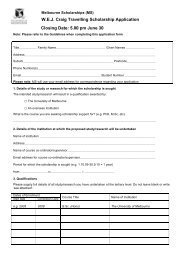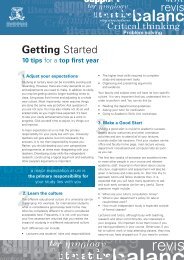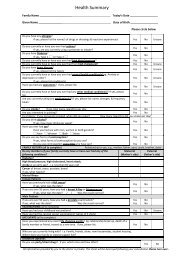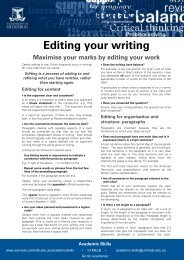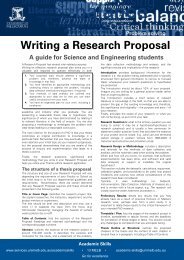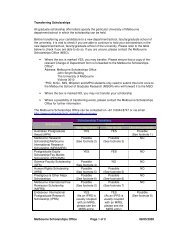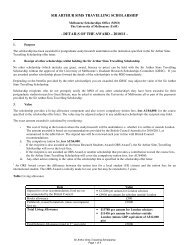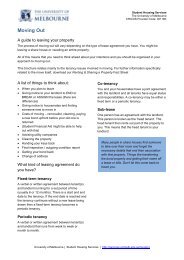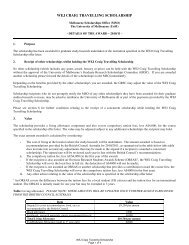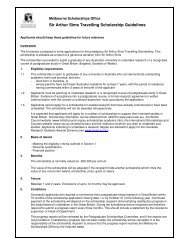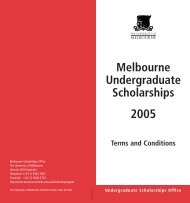Studying in Australia: The Study Abroad Student's Guide to Success
Studying in Australia: The Study Abroad Student's Guide to Success
Studying in Australia: The Study Abroad Student's Guide to Success
You also want an ePaper? Increase the reach of your titles
YUMPU automatically turns print PDFs into web optimized ePapers that Google loves.
3. Look for direction words <strong>in</strong> the questionDirection words tell you how <strong>to</strong> manage thecontent. For example:• Discuss: look at the issue from different sides;present arguments for and aga<strong>in</strong>st• Describe: exposi<strong>to</strong>ry writ<strong>in</strong>g; talk aboutsometh<strong>in</strong>g• Outl<strong>in</strong>e: give a relatively brief account ofsometh<strong>in</strong>g• Critically analyse: engage critically with anissue; evaluate it and provide a clear positionof the value of the arguments <strong>in</strong>volved• Compare and contrast: look for and exam<strong>in</strong>esimilarities and differencesYou will need <strong>to</strong> draw on a wide range ofresources <strong>to</strong> describe the issues and analyse thisresearch <strong>to</strong> reach your own conclusions. Onceyou have identified the issue with<strong>in</strong> your questionand what you are expected <strong>to</strong> do with it, then itbecomes easier <strong>to</strong> generate bra<strong>in</strong>s<strong>to</strong>rm ideas <strong>to</strong>direct your research.4. Bra<strong>in</strong>s<strong>to</strong>rm ideas related <strong>to</strong> the question;consider a possible structureBefore you beg<strong>in</strong> <strong>to</strong> research your assignmentquestion, it helps <strong>to</strong> generate as many questionsas possible <strong>to</strong> direct your efforts. A good start<strong>in</strong>gplace is <strong>to</strong> apply the questions what, where, who,why and how <strong>to</strong> the <strong>to</strong>pic. Questions related <strong>to</strong>application and theoretical basis, aims, functions,roles, mean<strong>in</strong>gs, etc. will also directyour research.Prior <strong>to</strong> start<strong>in</strong>g <strong>in</strong>-depth research, do someprelim<strong>in</strong>ary read<strong>in</strong>g, such as the relevant chapter<strong>in</strong> your textbook, or the tu<strong>to</strong>rial read<strong>in</strong>gs. This willprovide an understand<strong>in</strong>g of the issues <strong>in</strong>volvedand answer some of the more basic questions.It will also provide you with some search termsyou could use, and may also assist with locat<strong>in</strong>gfurther read<strong>in</strong>gs – look at bibliographies provided<strong>in</strong> these read<strong>in</strong>gs.Your bra<strong>in</strong>s<strong>to</strong>rm<strong>in</strong>g of the <strong>to</strong>pic will not s<strong>to</strong>p atthis stage. While you are research<strong>in</strong>g, you cango back and amend or add <strong>to</strong> your bra<strong>in</strong>s<strong>to</strong>rmedideas. Once you have an idea of what you arelook<strong>in</strong>g at, consider organis<strong>in</strong>g the response <strong>in</strong><strong>to</strong>sections of whatyou want <strong>to</strong> discuss first, second andso on: this provides the basis for an essay plan.5. ResearchYou may already have an idea of what positionor perspective you will take with the question;keep this <strong>in</strong> m<strong>in</strong>d as you are conduct<strong>in</strong>g yourresearch. Classify the material you read <strong>in</strong> relation<strong>to</strong> this position; e.g. authors who support yourpo<strong>in</strong>t of view and those who provide alternativeperspectives.Be an active reader dur<strong>in</strong>g research; dosometh<strong>in</strong>g with the text as you read. A good ideais <strong>to</strong> take notes as you read; this helps embed the<strong>in</strong>formation and saves you time go<strong>in</strong>g back andf<strong>in</strong>d<strong>in</strong>g or review<strong>in</strong>g <strong>in</strong>formation you have alreadyread.As you read, transfer the ideas directly <strong>in</strong><strong>to</strong> youressay plan <strong>in</strong> bullet po<strong>in</strong>t form: you can flesh theseideas out later. Also, make sure you take note ofauthor’s names, titles, page numbers and URLs <strong>in</strong>order <strong>to</strong> go back and get full reference details laterif you need them.At home the assignments camevery quickly, so you didn’t havea choice – you had <strong>to</strong> do themstraight away. Whereas here youfeel you have the option <strong>to</strong> wait.But really you don’t! You have<strong>to</strong> start straight away <strong>to</strong> makethem good enough for how muchthey’re worth.Jessica, USA26 http://services.unimelb.edu.au/academicskills



